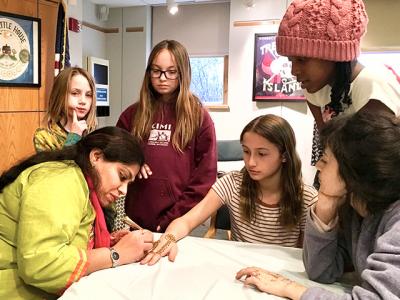An Eastern Tradition Kept Alive

The ancient Indian tradition of mehndi, or henna body art, goes back at least 2,000 years, when it was detailed in the Kama Sutra as one of the necessary arts a woman needed to learn in order to please and seduce.
But over the last 100 years, it has served a particular purpose at wedding rituals, when a bridegroom would hold a bride’s hand and search for his name hidden within the wavelike, wine-colored lines and floral trellises that covered her extremities. It was a perfect icebreaker, particularly in traditional Indian marriages in which the newlyweds were meeting for the first time.
In 1995, Eakta Shah became a 21-year-old arranged-marriage bride in India when her family decided that she should marry Darshan Gandhi of Gujarat, India’s westernmost state and the birthplace of Mahatma Gandhi, although the two are not related.
Today, Ms. Gandhi lives with her husband and children in Riverhead, where she is a bus driver for the Riverhead School District and her husband works for a car dealership. Their eldest son is at a university studying engineering, while another is in 10th grade. By many standards, they’re living the American dream. But it’s her business as a coveted henna artist across the East End that keeps her rooted to her Indian heritage and fulfills her childhood dream.
Last week Ms. Gandhi was at the Montauk Library, where children had to be turned away, said Jacqueline Bitonti, the youth services librarian there, because the three-hour henna session for kids of all ages was at capacity. It was the third time Ms. Gandhi had been hired by the library, and each time, Ms. Bitonti said, the event was exceptionally well attended.
With her bagful of small paper cones filled with henna paste, she is often found dressed in traditional Indian wear and hunched over outstretched hands at libraries from Sayville to Montauk, festivals around the East End including the annual Strawberry Festival in Mattituck and the Montauk Music Festival, as well as at weddings and private parties. Although she also works at Indian weddings and baby blessings, she said 90 percent of her clients are American. One family even hired her for a wedding in Costa Rica. She was hesitant, but her husband said, “Are you crazy? You must go!”
“It’s so awesome,” she said of her thriving business, which first caught her fancy when she was a young girl in India. “I am so grateful that I can do something I truly love as well as keep my Indian tradition going.”
As a 10-year-old in her hometown of Baroda, the third-largest city in Gujarat, she enrolled in mehndi classes and continued to practice the art over the years. While her mother encouraged her to pursue her passion professionally, her father said absolutely not, as he did not consider it a worthy calling.
After marrying and immigrating to America in 1995, Ms. Gandhi worked in several small tobacconist shops the couple owned in Melville, Hicksville, and later in Ridge, often spending 13 hours a day behind the counter.
Then, in 2008, her husband decided they needed to spend more family time. “I was devastated,” she said. “I’m such a people person. I loved talking to the older customers who would stop by every day just to tell me their stories.”
But her husband was adamant and sold the shops and moved the family to Riverhead, where she became a bus driver at the local school. Today, she also trains drivers for the district and in between her morning and afternoon shifts works part time at Home Depot.
Her henna artistry was first noticed 10 years ago, when she painted someone’s hands for a party. “After that, people kept asking me to do it more and more, and the business just grew,” she said. Her rate is $125 an hour or about $20 for a quick design.
The henna plant, which Ms. Gandhi buys from Rajasthan, a state on the border with Pakistan, arrives in powdered form. She then mixes the powder with various essential oils, and even tea water, to form a paste, which 8 to 10 hours later turns rusty red. Of the many myths attached to henna, one claims that when it is applied to a bride-to-be’s hand, the deeper the stain, the nicer the mother-in-law, which, naturally, translates to a happy marriage.
But in Montauk last week, her only concern was the 30-plus young hands to adorn in three hours. She works, as traditional henna artists do, without the use of a template or reference. “I just see a hand and form a pattern in my head. Every design is unique,” she explained, and based on the contours and shape of the individual’s hand. Her own steady hand is key, she said, as is patience, practice, and a sense of proportion.
“My husband and sons are so supportive of my business,” said Ms. Gandhi. As for her father, who forbade her to pursue it in India? “He is so happy for me now and keeps apologizing for not letting me do it all those years ago.”
She smiled and shrugged. The world is a very different place today, she told her father. Then she went back to her work, painting intricate, filigree paisleys and peacocks, executed with quicksilver strokes, on the backs of miniature hands, each one finished with a sprinkle of glitter for the ultimate girly touch.
